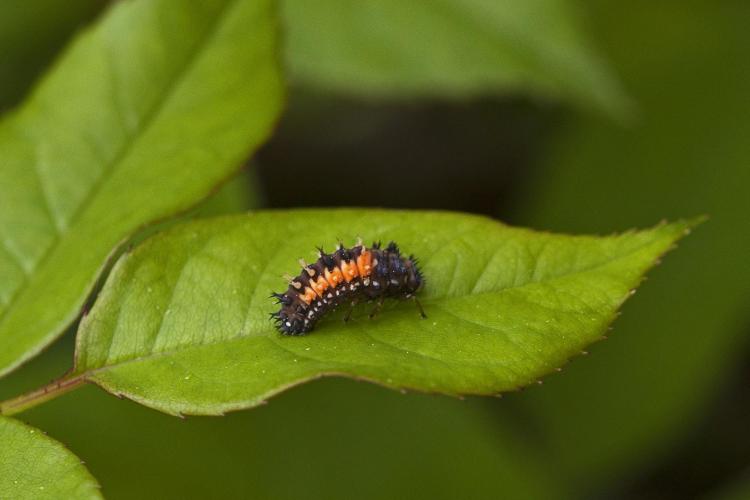A ladybug's bright colors advertise toxic chemical defenses
Evolutionary biologists have noted that effective chemical defenses promote gregarious behavior
During fall in the mountains, ladybugs migrate uphill, forming dense overwintering populations, defended by the alkaloids of thousands of insects."
Virtually everyone can identify ladybugs and most are pleased to see the brightly colored beetles, while gardeners treasure them because adults eat about 25 aphids per day while the larvae eat nearly ten times as many. But their bright coloration is not an accident of nature, nor some insect's desire to delight children. Their colors are an important signal to other species.
Edward Bagnall Poulton, in his book entitled "The Colours of Animals" coined the word aposematic, referring to bright colors in striking patterns that warned predators of effective and dangerous defenses. Aposematic coloration is seen on skunks, poison dart frogs, monarch butterflies, bees and wasps, to mention just a few.
The bright colors and striking pattern of seven-spotted ladybugs (hereafter SSL), Coccinella septempunctata, are the conspicuous signals warning of alkaloids that are synthesized by the beetle -- a few ladybug species acquire chemical defenses in their diets. The alkaloids synthesized by and defending SSL are precoccinelline and coccinelline, which are distasteful in minute amounts and harmful or lethal in large amounts. They are found in the eggs, larvae and adults.

At the top of the page: A larval ladybug on a flower bud. Above: A larval ladybug on a leaf. Photos by Jeff Mitton.

A seven-spotted ladybug lingers in the open without fear of predators. Photo by Jeff Mitton.
Evolutionary biologists have noted that effective chemical defenses promote gregarious behavior, for a dense congregation of defended insects amplifies the impact of the aposematic signal on predators. Gregarious behavior is seen in two phases of the life cycle of SSL. First, ladybugs lay their bright yellow eggs in dense clusters, often with the eggs touching. During fall in the mountains, ladybugs migrate uphill, forming dense overwintering populations, defended by the alkaloids of thousands of insects. Dense populations covering rocks can be found on the peaks of Green Mountain, Bear Peak and South Boulder Peak in the winter and an enormous aggregation forms at the observatory on the Peak of Mount Lemmon, above Tucson.
Both the larvae, which look like little dinosaurs, and the adults present their defensive alkaloids to investigating predators by reflexive bleeding. By wiggling a leg the right way, they release alkaloid laced blood from the tibio-femoral joint. If they are poked, they reflexively bleed from only the leg joint closest to the insult. The defensive alkaloids can be detected both by fragrance and physical contact.
Evolutionary biologists wanted to test the hypothesis that heavily defended SSL would have brighter aposematic coloration. Both the chemical defenses and the aposematic coloration are energetically expensive, so beetles do not synthesize either without a good reason. The orange to red color of the elytra (wing covers) is produced by carotene, which is produced by symbiotic microbes in the gut. The greater the amount of carotene, the redder the elytra and the brighter the signal. But in a laboratory experiment that compared low and high energy diet treatments, the concentrations of carotene and precoccinelline were lower for both males and females in the low energy treatment.
Paradoxically, coccinelline exhibited a different pattern. Its concentrations did not differ between the high and low energy food treatments. But the correlation between coccinelline and carotene was positive in females in both treatments, consistent with the hypothesis that a brighter signal indicated higher defenses. Paradoxically, coloration and concentration of coccinelline were negatively correlated in both diet treatments in males. More work is needed to fully understand the relationship between the intensity of the aposematic signal and the concentration of defensive chemicals.
It can be valuable to remember that aposematic coloration marks animals that wield effective defenses. I knew about this a decade ago when I was scuba diving in Bonaire and had found a lovely gem, 4-inch-long bristle worm with bright lavender and yellow markings. I was so excited with my discovery that I wanted to share it with divers that had professional cameras. I gestured wildly and beckoned and then pointed, but they did not see what I was pointing at. I moved closer, pointing with my index finger within a few millimeters of the worm--that worked and they moved in for photos. Later, on the boat, the dive master noticed me studying my index finger, which had white spicules (fragile hollow tubes filled with poison) projecting from it--the defense of the bristle worm. When I explained what I had done, the dive master laughed so hard he nearly fell out of the boat. I felt sheepish because the professional biologist had ignored the bristle worm's aposematic coloration. My throbbing, tender finger reminded me of my folly for the next week.

